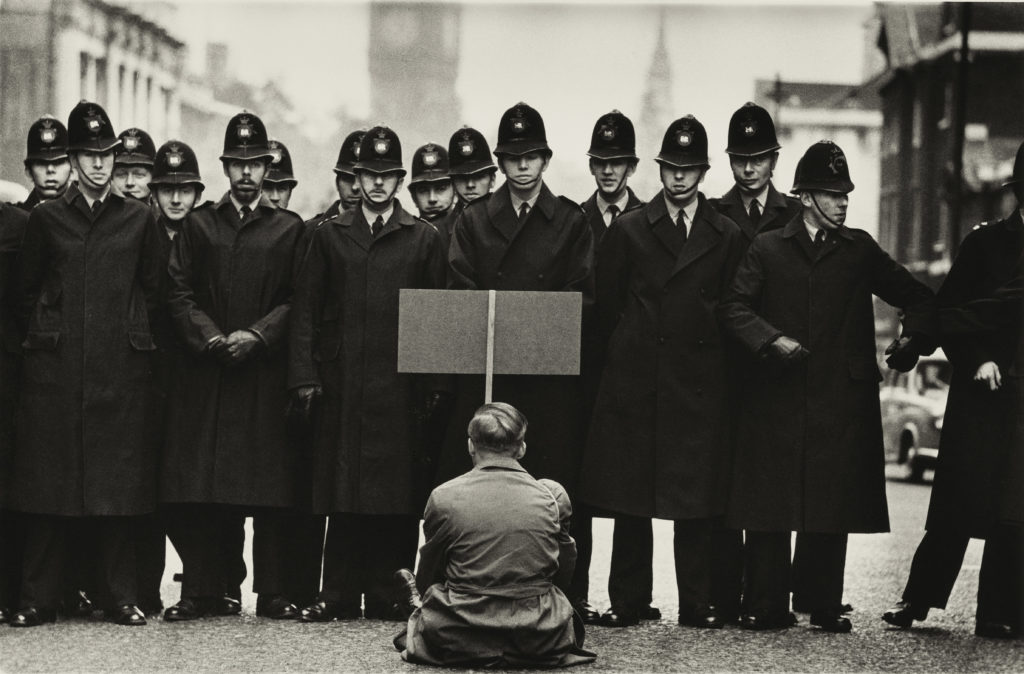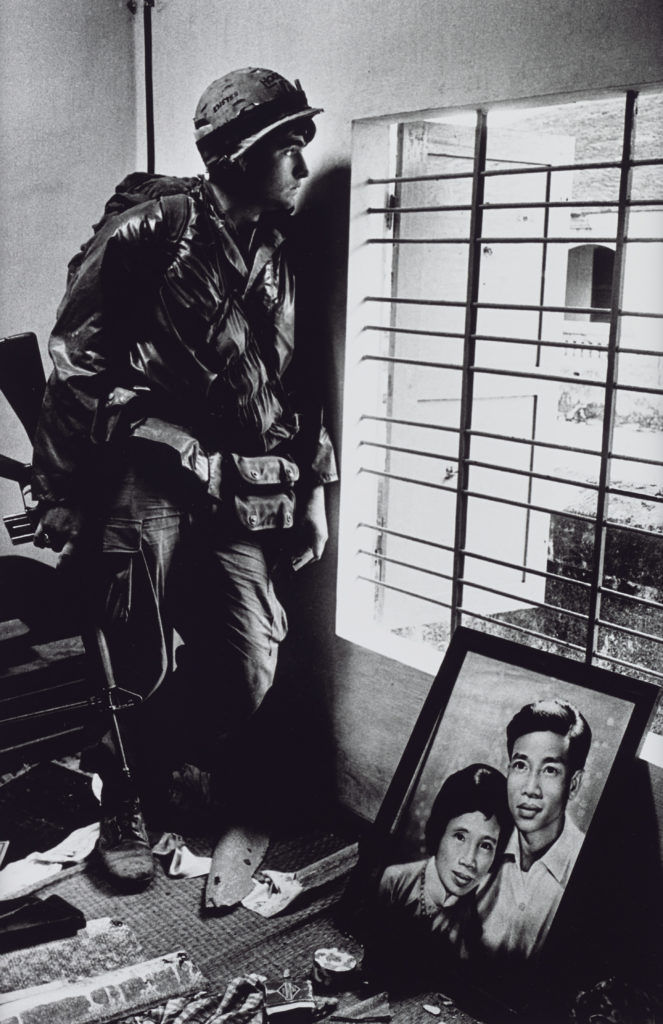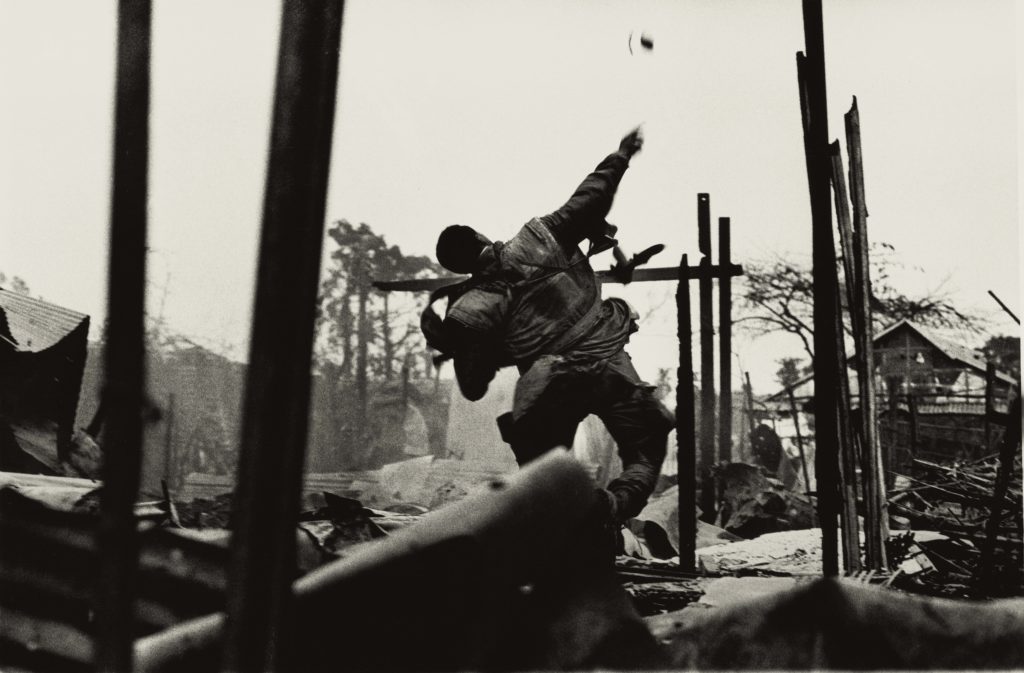Changes in Looking: Viewing Conflict Photography // Don McCullin
by William Davie

The Tate Britain’s deeply moving retrospective of photographer Don McCullin signals a sea change in the institution’s outlook on photography. McCullin, the first living British photographer to have a career survey at any of the Tate galleries, forged his reputation as a conflict photographer, an arena that he has worked tirelessly within for over six decades. As a method for restoring a semblance of order to what he has had to witness—an attempt to right a wrong— McCullin photographs the ever-shrinking English countryside.
These works, which are seen in the final room of the retrospective, are, to put it bluntly, beautiful—if we, the viewer, are to take them at face value. But for McCullin, and now us, these images are loaded. If less overtly, the works are as politicized as his documentation of famine and wars in Africa, the troubles in Northern Ireland, destitution in London’s east end, and the industrial north of England. Owing to the rate at which urbanization is destroying the countryside, they are tainted with the poignancy, perhaps even survivor’s guilt, that McCullin might have felt as he shot them.
However, a substantial portion of the rest of the retrospective is dedicated to the aftermath of unimaginable pain, suffering, and violation inflicted upon humans by other humans. There are fewer photographs showing conflict than expected, given the amount of time McCullin has spent on frontlines. But it is within these photographs where we witness, from the removed safety of the grey-walled galleries and inside the uniformly framed, black and white, gelatin silver prints, lives so alien to us, that it feels as if the setting of the gallery remains on the verge of making the suffering of McCullin’s subjects palatable.
In Cyprus (1964), the face of woman who has just discovered that her husband has been killed during the Cyprus crisis is contorted by grief. She clutches her hands together in futile prayer as onlookers and a crying boy pushes his hand against her chest, his fingers splayed open. Likewise, in A Palestinian Mother in Her Destroyed House, Sabra Camp (1982), a mother in a long dark robe and headscarf stands with her arms outstretched in exclamation, her mouth open, to a person beyond the camera, in a building that has been destroyed by a bomb.
Both lives are ruined. But it is my reaction to these photographs—to their suffering and their pain, devastated by conflict— that I suspect is shared by many others my age, which is the survey’s greatest asset: it questions our relationship to images of violence and its aftermath.

I am 26-years-old. I grew up with violence in the television shows and in the films I watched; there was violence in the video games I played; violence and its devastating effects from across the globe, even without fully recognizing it, dominating the news daily, and now, thanks to the internet, there is an abundance of violent images immediately available to me at anytime, anywhere I go. But the image is not real. I have never experienced suffering like this. So, when I see these photographs, a curiosity to know more about their context and a condemnation of the actions that caused them comes in an obvious and superficial manner, but I am never shocked. In fact, I feel a vulgar familiarity that I fear could all too easily and too soon become indifference.
This comes down to two factors that are outlined throughout the retrospective. First: the demand for and our consumption of these types of images. In the digital age, our ability and expectancy to receive real-time news reports and updates about events from around the globe has allowed technology to both give ever-greater credence to photojournalism, of which war photography is just one aspect, but now, is radically redefining it with the proliferation of smartphones and the ability for people directly involved to photograph and record videos. Speaking about the first time he witnessed a public execution in 1965, of a man who had detonated a bomb in a Saigon market, McCullin recalled being surrounded by journalists and photographers as the man was executed by firing squad before one of the executioners stepped forward grabbing the man by the hair and shooting him again, through the head. The photographers and journalists screamed and cajoled, “My God, that was great stuff—did you get it, did you get it?” He did not. Further still, McCullin never relayed this information back to his handlers at The Sunday Times for fear of being labelled “a rank amateur not to have got such a picture.”
But what does this say about the demand for images of such cruelty, even fifty years ago? Why are they so highly sought after; because people will see them on the front of a newspaper and buy it? Exclusivity? What right did these photographers have to photograph this man’s execution and, more broadly, what good is it going to do—it will not bring back the people he killed when he detonated his bomb in the market. It will not bring back the woman’s husband in Cyprus. It will not rebuild the mother’s house in Sabra Camp.
During a 2016 interview with CNN, when asked whether he feels his photographs have helped change anything, McCullin stated, “I feel that I haven’t made any change or difference, every year there is a new terrible conflict.”
And with each new face rigid with fear, distraught with pain, with every life broken that I see as I go through McCullin’s retrospective, I am reminded of the indelible details that photographer Jon Steele recalls in Reporters at War. While on assignment in Sarajevo during the Bosnian war, Steele had heard a high-powered round being fired. It was a Serbian sniper. Minutes before, he had promised to give sweets to children playing in a nearby road. The street went quiet, he says. He rushed out of the building he was in and followed the eye-line of a now screaming woman to the body of a little girl lying on her back in a pool of blood in the middle of the road. “I didn’t go rush up to her, I didn’t try and help, I ran to the truck and got my camera, I started filming the situation.” he continues. “Some men picked her up and put her in the back of a car—and they were actually blocking my shot and I grabbed one of the men on the back of the shoulder, yanked him back and I went in with the camera. And I was looking at her through the eyepiece, I don’t know if she was conscious or falling into unconscious, but she just kind of looked into the lens and then her eyes just kind of lost focus and the car took off and went away.” He continues, saying that later, while cleaning dust off the glass of the lens and seeing his face, specifically his eyes, in the reflection, something hit him: “the last thing she saw in her life, was her own-self dying. I did that to her.”
Second and more nuanced, and as a result of the first, is the language we use in association with such images, and what it does to them.
Harper’s Magazine has described McCullin as “our era’s greatest living war photographer,” his work has been labelled ‘genius’ and his photographs, particularly Shell-shocked US Marine, The Battle of Huế, taken during the Vietnam War, in 1968, which shows a muddied, shell-shocked marine, stunned and staring without blinking, far beyond McCullin’s camera, clutching his rifle with both hands, as ‘iconic.’
How can we measure ‘greatness’ in this instance, what makes his work ‘genius’? Is that marine proud that his psychological trauma, his suffering, is seen by the world as ‘iconic’?

During the same interview with CNN, the interviewer asks, in reference to this image, what, after all these years and knowing what an impact this one image has had, what does it say to him now? His response is that he is “Sick and tired of looking at it” and that he feels that “this photograph has cancelled out all the others that came before it,” that he thinks are more powerful, that show the suffering and sacrifice of both the Americans and Vietnamese soldiers and civilians.
This is clearly seen in the retrospective. Yet, nearly every bit of coverage dutifully notes its presence and its iconic stature in the exhibition, as if it would be incomplete if it was not included.
What the associated language used in relation to these images also does is fan the flames of the myth of the war photographer, or what Finbarr O’Reilly, noted conflict photographer and author calls the “hard-living, scarf-wearing loner dashing from one war zone to the next, with romantic partners as expendable as bullets.” And, although McCullin, now 86, is quick to dismiss this, it is clear from media coverage that there is, in part, a mythologizing appeal to his story: a full-lived-life, demons warded off, and now recognized with one of the highest accolades of the art industry.
He continues, “I’m not proud of [conflict photography] and the laurels that come with it sit very uneasily upon my head, I have won prizes that sit in my garden shed, I find it difficult to feel rewarded at the cost of other people’s suffering.”
Long after you have left, with certain distinct details trapped vividly in your consciousness, the answers to the overarching line of questioning in the retrospective I have talked about are sought quietly, in the unexpected and deepest moments of sincere and honest reflection.
Don McCullin runs at the Tate Britain through May 6, 2019.